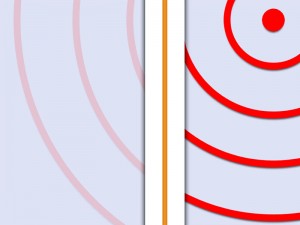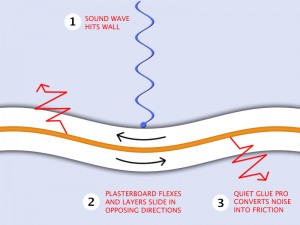SoundProofing Basics
To understand QuietGlue Pro we must first understand the behaviour of sound.
Sound is essentially vibration. Soundproofing is the process of reducing the level of vibration that gets from one room to another.
Sound radiates from its source in all directions, vibrating the air in a wave like motion. When it hits a solid object such as a plasterboard wall, the vibrations travel through the structure until they reach the other side, where once again they become airborne and reach our ears. Some of the energy is absorbed whilst travelling through the wall, giving us a certain level of sound reduction.
Heavier walls absorb more energy resulting in more effective soundproofing. However there are some limitations when you focus solely on the mass of your wall. Firstly, heavy walls, like all solid objects do still resonate, allowing some frequencies to pass through almost unhindered. Secondly, they are subject to the law of diminishing returns: as the mass of the wall is increased (normally by adding layers of plasterboard), the level of improvement quickly tails off. In order to achieve a high level of sound reduction, your wall or ceiling may have to be so heavy as to be impractical. The sheer amount of mass you may need may take up too much space, cost too much money and you may even have to reinforce the building to take the weight!
QuietGlue Pro has been engineered specifically to overcome these limitations. You can now achieve high levels of sound reduction through your wall or ceiling structure that would be impractical to achieve with plasterboard or concrete blocks alone.
How Does QuietGlue Pro Work?
When sound hits the wall, the plasterboard is caused to flex like the top of a drum. Even after the noise source has become silent, the plasterboard continues to flex backwards and forwards radiating sound for a short period of time. This vibration is the enemy of soundproofing as it causes noise to be transmitted easily through a structure. However, QuietGlue Pro targets vibration with its advanced sound damping formula.
When two sheets of plasterboard on a wall are caused to vibrate, they are effectively rubbing against each other as they flex back and forth. With a layer of QuietGlue Pro between them the level of friction is increased, causing this ‘shearing’ motion to convert the energy to heat. In practical terms the heat produced is tiny, but the process removes a significant amount of energy from the vibration.
Due to QuietGlue Pro’s remarkable noise damping properties, far less sound is heard on the other side of the wall compared to a conventional wall panel.



